|
|
|
Sort Order |
|
|
|
Items / Page
|
|
|
|
|
|
|
| Srl | Item |
| 1 |
ID:
131675


|
|
|
| 2 |
ID:
147078
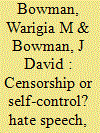

|
|
|
|
|
| Summary/Abstract |
In 2013, the Kenyan government adopted a hybrid censorship strategy that relied on regulation, the presence of a strong security state, and the willingness of Kenyans to self-censor. The goal of this censorship strategy was to ensure a peaceful election. This study examines two issues. First, it investigates steps taken by the Kenyan government to minimise hate speech. Second, it explores how efforts to minimise hate speech affected citizen communications over SMS during the 2013 election. An initial round of qualitative data was gathered (n = 101) through a structured exit interview administered election week. A statistically significant, representative sample of quantitative data was gathered by a reputable Kenyan polling firm (n ≥ 2000). Both sets of empirical data indicate that Kenyan citizens cooperated in large part with efforts to limit political speech. Yet speech was not always completely “peaceful’. Rather, voters used electronic media to insult, offend, and express contentious political views as well as express peace speech. This study argues that the empirical evidence suggests hate speech over text messages during the Kenyan election declined between 2008 and 2013.”
|
|
|
|
|
|
|
|
|
|
|
|
|
|
|
|
| 3 |
ID:
097018


|
|
|
|
|
| Publication |
2010.
|
| Summary/Abstract |
This article examines the electoral consequences of variation in voter turnout in the United States. Existing scholarship focuses on the claim that high turnout benefits Democrats, but evidence supporting this conjecture is variable and controversial. Previous work, however, does not account for endogeneity between turnout and electoral choice, and thus, causal claims are questionable. Using election day rainfall as an instrumental variable for voter turnout, we are able to estimate the effect of variation in turnout due to across-the-board changes in the utility of voting. We re-examine the Partisan Effects and Two-Effects Hypotheses, provide an empirical test of an Anti-Incumbent Hypothesis, and propose a Volatility Hypothesis, which posits that high turnout produces less predictable electoral outcomes. Using county-level data from the 1948-2000 presidential elections, we find support for each hypothesis. Failing to address the endogeneity problem would lead researchers to incorrectly reject all but the Anti-Incumbent Hypothesis. The effect of variation in turnout on electoral outcomes appears quite meaningful. Although election-specific factors other than turnout have the greatest influence on who wins an election, variation in turnout significantly affects vote shares at the county, national, and Electoral College levels.
|
|
|
|
|
|
|
|
|
|
|
|
|
|
|
|
| 4 |
ID:
110632
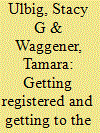

|
|
|
|
|
| Publication |
2011.
|
| Summary/Abstract |
Each election year, colleges and universities across the nation witness a plethora of on-campus voter registration activities. The results of these drives are most often assessed by tallying the number of voter registration cards collected. Little has been done, however, to more carefully investigate these results. As a first attempt to examine postdrive results more thoroughly, we ask two questions. First, do students who register through an on-campus voter registration drive actually make it to the voting booth? Second, does providing basic information about the voting process increase turnout among students who register through an on-campus voter registration drive? In this study, we investigate the overall turnout rate of students registering to vote in the 2008 presidential election through on-campus registration drives by validating votes through the office of the county voting registrar. We then compare the turnout rate of students who registered through the on-campus drives with the turnout rate of similar young people nationwide. Finally, we investigate whether the provision of information through certain avenues boosts turnout. Our findings show that students who registered through an on-campus voter registration drive turned out to vote at a higher rate than similar young people nationwide. Additionally, we found small but important effects of information provision through different formats.
|
|
|
|
|
|
|
|
|
|
|
|
|
|
|
|
| 5 |
ID:
178146
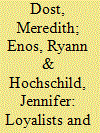

|
|
|
| 6 |
ID:
129285


|
|
|
| 7 |
ID:
102072
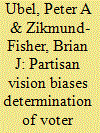

|
|
|
| 8 |
ID:
092275
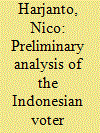

|
|
|
| 9 |
ID:
174468


|
|
|
|
|
| Summary/Abstract |
Although restricting formal voting rights—voter suppression—is not uncommon in democracies, its incidence and form vary widely. Intuitively, when competing elites believe that the benefits of reducing voting by opponents outweigh the costs of voter suppression, it is more likely to occur. Internal political and state capacity and external actors, however, influence the form that voter suppression takes. When elites competing for office lack the ability to enact laws restricting voting due to limited internal capacity, or external actors are able to limit the ability of governments to use laws to suppress voting, suppression is likely to be ad hoc, decentralized, and potentially violent. As political and state capacity increase and external constraints decrease, voter suppression will shift from decentralized and potentially violent to centralized and mostly non-violent. We illustrate our arguments by analyzing the transition from decentralized, violent voter suppression through the use of lynchings (and associated violence) to the centralized, less violent suppression of black voting in the post-Reconstruction South. We also place the most recent wave of U.S. state voter suppression laws into broader context using our theoretical framework.
|
|
|
|
|
|
|
|
|
|
|
|
|
|
|
|
| 10 |
ID:
090831


|
|
|
|
|
| Publication |
2009.
|
| Summary/Abstract |
The theory of spatial voting has played a large role in the development of important results across many areas of political science. Directly testing the foundational assumptions of spatial voting theory, however, has not been possible with existing data. Using a novel survey design, this article obtains estimates of voter ideology on the same scale as candidate positions. The results of this scaling demonstrate that voters possess meaningful ideologies and, furthermore, that these beliefs are strongly related to the sorts of policy proposals considered in Congress. These ideology estimates are then used to uncover the actual relationships between ideology and vote choice for citizens of various types in the 2004 presidential election. Although the choices of independent voters are shown to be largely consistent with the assumptions of spatial voting theory, the decision rules used by partisans differ strongly from what unbiased spatial voting would imply. Although partisans do converge toward the behavior of independents, and hence toward the assumptions of spatial voting theory, as information levels increase, we see that even highly informed partisans show significant differences from what would be implied by unbiased spatial voting theory.
|
|
|
|
|
|
|
|
|
|
|
|
|
|
|
|
| 11 |
ID:
127960
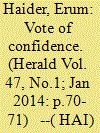

|
|
|
| 12 |
ID:
131663
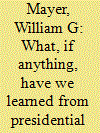

|
|
|
|
|
|
|
|